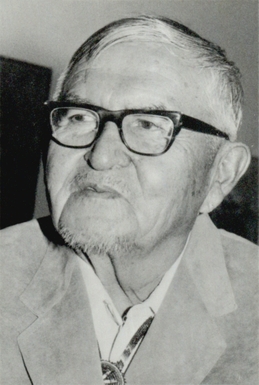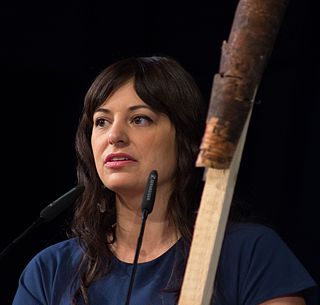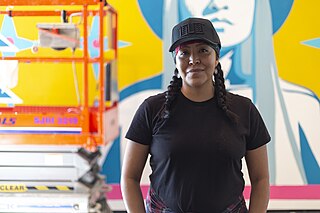Related Research Articles

The Institute of American Indian Arts (IAIA) is a public tribal land-grant college in Santa Fe, New Mexico, United States. The college focuses on Native American art. It operates the Museum of Contemporary Native Arts (MoCNA), which is housed in the historic Santa Fe Federal Building, a landmark Pueblo Revival building listed on the National Register of Historic Places as Federal Building. The museum houses the National Collection of Contemporary Indian Art, with more than 7,000 items.

Allan Capron Houser or Haozous was a Chiricahua Apache sculptor, painter, and book illustrator born in Oklahoma. He was one of the most renowned Native American painters and Modernist sculptors of the 20th century.

Harry Eugene Fonseca was a Nisenan Native American artist, and illustrator. He was an enrolled citizen of the Shingle Springs Band of Miwok Indians.

Rebecca Belmore D.F.A. is a Canadian interdisciplinary Anishinaabekwe artist who is notable for politically conscious and socially aware performance and installation work. She is Ojibwe and a member of Obishikokaang. Belmore currently lives in Toronto, Ontario.
The Fort Sill Apache Tribe of Oklahoma is the federally recognized Native American tribe of Chiricahua Warm Springs Apache in Oklahoma.

James Luna was a Puyukitchum, Ipai, and Mexican-American performance artist, photographer and multimedia installation artist. His work is best known for challenging the ways in which conventional museum exhibitions depict Native Americans. With recurring themes of multiculturalism, alcoholism, and colonialism, his work was often comedic and theatrical in nature. In 2017 he was awarded a Guggenheim Fellowship.

Horace Poolaw (1906–1984) was a Kiowa photographer from Mountain View, Oklahoma.

This is a chronological list of significant or pivotal moments in the development of Native American art or the visual arts of the Indigenous peoples of the Americas. Earlier dates, especially before the 18th century, are mostly approximate.

Richard Aitson was a Kiowa-Kiowa Apache bead artist, curator, and poet from Oklahoma.
Shelley Niro is a Mohawk filmmaker and visual artist from New York and Ontario. She is known for her photographs using herself and female family members cast in contemporary positions to challenge the stereotypes and clichés of Native American women.

Bob Haozous is a Chiricahua Apache sculptor from Santa Fe, New Mexico. He is enrolled in the Fort Sill Apache Tribe.
America Meredith is a painter, curator, educator, and editor of First American Art Magazine. America Meredith is an artist and comes from a Swedish-Cherokee background who blends pop imagery from her childhood with European and Native American styles.

Candice Hopkins is a Carcross/Tagish First Nation independent curator, writer, and researcher who predominantly explores areas of indigenous history, and art.
Cara Romero is an American photographer known for her digital photography that examines Indigenous life through a contemporary lens. She lives in both Santa Fe, NM and the Mojave Desert. She is an enrolled citizen of the Chemehuevi Indian Tribe.
Zoë Marieh Urness is a photographer of Alaskan Tlingit and Cherokee Native American heritage. She creates portraits of modern Indigenous cultures in traditional regalia and settings.
Frank Raymond LaPena, also known as Frank LaPeña and by his Wintu name Tauhindauli, was a Nomtipom-Wintu American Indian painter, printmaker, ethnographer, professor, ceremonial dancer, poet, and writer. He taught at California State University, Sacramento, between 1975 and 2002. LaPena helped defined a generation of Native artists in a revival movement to share their experiences, traditions, culture, and ancestry.

Lynnette Haozous a Native American painter, printmaker, jeweler, writer, and actor. She is an enrolled member of the San Carlos Apache Tribe and of Chiricahua Apache, Navajo, and Taos Pueblo ancestry. Haozous works in acrylics, watercolors, spray paint, jewelry, screen-printing, writing, and acting on stage and in film. She is known for her murals and uses a blend of art and advocacy to bring attention to social conditions and injustices.
References
- ↑ Weatherford, Elizabeth (July 2010). "Nancy Marie Mithlo". Native American Film + Video Festival. Retrieved 2020-08-24.
- ↑ Mithlo, Nancy Marie (2020). Knowing Native Arts. Lincoln: University of Nebraska Press. p. 200. ISBN 978-1-4962-02123.
- 1 2 "Nancy Marie Mithlo". TLAXCALA. Retrieved 2020-08-24.
- ↑ Weideman, Paul (15 August 2014). "A Gaze of Intelligence: The Photos of Native Visionary Horace Poolaw". Santa Fe New Mexican. Retrieved 2020-08-24.
- ↑ Thackara, Tess (2019-05-31). "The Hand of Native American Women, Visible at Last". The New York Times. ISSN 0362-4331 . Retrieved 2020-08-24.
- ↑ Pulkka, Wesley (11 August 2013). "Poignant Shows at 516 Arts". Albuquerque Journal. p. 37. Retrieved 2020-08-24– via Newspapers.com.
- ↑ Centeno, Jimmy (2019-02-27). "The People's Home: The United American Indian Involvement Photographic Project". Sounds and Colours. Retrieved 2020-08-24.
- 1 2 Krol, Debra Utacia (September 2012). "Manifestations: New Native Art Criticism" . Native People's Magazine: 64 – via EBSCOhost.
- ↑ McGeough, Michelle (2012). "Indigenous Curatorial Practices and Methodologies". Wíčazo Ša Review. 27 (1): 13. doi:10.5749/wicazosareview.27.1.0013.
- ↑ Birnbaum, Robert (2014-12-13). "The Best Coffee Table Books of 2014". The Daily Beast. Retrieved 2020-08-24.
- ↑ Making history : the IAIA Museum of Contemporary Native Arts : Institute of American Indian Arts. Nancy Marie Mithlo. Albuquerque. 2020. p. 1. ISBN 978-0-8263-6210-0. OCLC 1154100532.
{{cite book}}: CS1 maint: location missing publisher (link) CS1 maint: others (link)